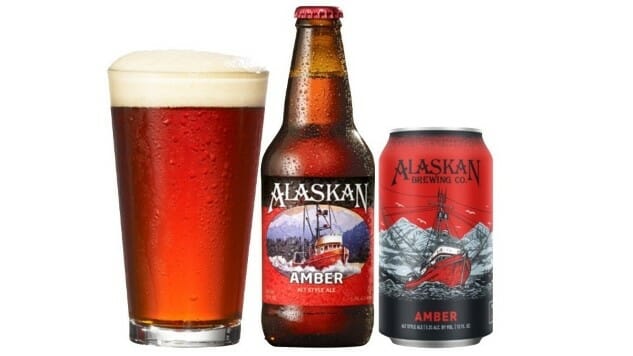My Month of Flagships: Alaskan Brewing Co. Amber Ale
Photo via Alaskan Brewing Co. Drink Features craft beer
This essay is part of a series this month, coinciding with the concept of Flagship February, wherein we intend to revisit the flagship beers of regional craft breweries, reflect on their influence within the beer scene, and assess how those beers fit into the modern beer world. Click here to see all the other entries in the series.
In the course of working on my recent essay entitled Endangered Beer Styles: Amber Ale, there was a moment when I wondered the following: Is this the longest thing that any beer writer has written on amber ale, as a style, in the last five years?
It certainly wouldn’t have to be a very long piece to qualify for that dubious honor. Very few column inches have been dedicated in recent memory to something that so many see as a pedestrian, unassuming, antiquated beer style, and that does feel like a shame. Although I’m not going to sit here and pretend that amber ale is secretly the world’s most fabulously underrated taste experience, they can be lovely beers in the hands of breweries that really care about them. The fact that they tend to hinge on subtlety is exactly why so many have gone the way of the dodo—we are at a uniquely un-subtle moment in the history of American craft beer, when audacious flavors rule and little thought is given toward any kind of delicacy or balance. And suffice to say, that’s a challenging arena for your classic amber ale to compete in.
That’s almost certainly true for Alaskan Brewing Co. and their longtime flagship Amber, although the brewery classifies it not as the expected “American amber ale” but as a German altbier, one of the closer Continental equivalents. The altbier style literally means “old” beer, referring to the way the amber, malty ales predate the lager beer styles (and lager yeast) with which Germany increasingly became associated from the mid-1800s onward. In its own way, though, altbier is something of a crossover between styles, because its ale yeast is allowed to ferment more slowly, at cooler temperatures than most ale styles—essentially an inverse of American steam beers/California common, in which lager yeast is allowed to get much warmer than normal. Perhaps unsurprisingly, these sorts of distinctions are increasingly lost on beer crowds that are more interested in pounding pints of sour fruit slushies, but it is what it is.
Unlike many of the flagships in this series, Alaskan Amber isn’t really a beer I have any personal history with—I don’t believe I’d ever sampled anything from the brewery until their entries began showing up for Paste blind tastings, and given that we never conducted a blind tasting of amber ales, I don’t know if I’ve ever tasted this beer until now. It is, therefore, the rare time when I go into tasting something with more or less zero preconceptions in mind, except an appreciation for its stubby bottle and decidedly retro, crimson label.
So with that said, let’s give it a taste.
Tasting: Alaskan Brewing Co. Amber
Tasting this beer really has the effect of transporting you to your favorite brewpub of the mid-90s or early 2000s—there’s something about it that is deeply nostalgic and evocative of a time when “full flavored” beers implied something so seemingly simple as a modicum of subtle malty sweetness and a more full sense of body than the mass-produced lager of the day. These were the styles of beers that converted countless drinkers away from yellow, fizzy, watery lager and set them down the path to becoming today’s connoisseurs of funky, terroir-driven wild ales, among other things. Without the likes of amber ale, would that really have been possible?
On the nose, Alaskan Amber is malt driven and evocative of mild sweetness, with a slightly musty quality and a fruity note reminiscent of red licorice, transitioning into a deeper, toastier breadiness. In other words, it smells the way that almost nothing does anymore, for better or worse.
On the palate, this is a fairly full-bodied, mouth-coating ale, with no shortage of warm maltiness, light caramel and a slight dusting of spice that is almost a bit like cassia bark. There are slight, piney hop notes on the palate, but not much bitterness to speak of—it isn’t quite balanced, but instead tilts gently in the direction of malt and mild sweetness, which has a quality like mild caramel, or perhaps toffee. Residual sweetness, however, is only mild—especially to the modern drinker who regularly consumes hazy IPAs and kettle sours pushing for maximum juiciness. To a palate that has become accustomed to those kinds of sugar levels, this likely wouldn’t register as sweet at all, although there is a current of red fruit notes running throughout as well.
Drinking this beer, I can’t help but think that it must be a more difficult pitch to sell these days, between the incredible level of competition (more than 8,000 breweries in the U.S.) and the prevailing trends that tilt away from even the mention of crystal malt or caramel flavors in most styles. And yet, it feels to me like there’s always a place for amber ale. These are good, unassuming, especially food-friendly beers that are only enhanced by the addition of burgers, or chicken wings, or a massive pile of nachos. Alaskan Amber is decidedly unpretentious, and could never be said to lack character. Here’s to another 30-plus years of flying its amber flag.
Jim Vorel is a Paste staff writer and resident craft beer geek. You can follow him on Twitter for much more drinks writing.